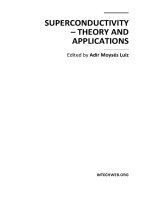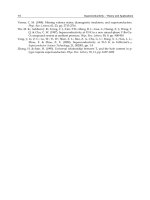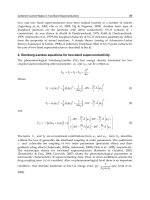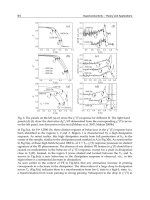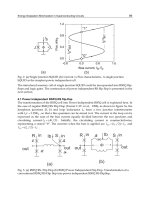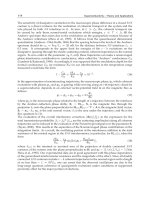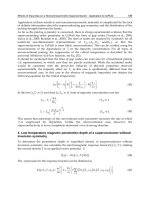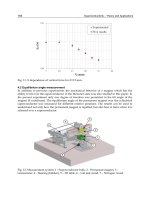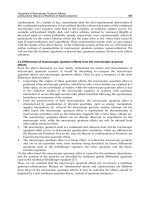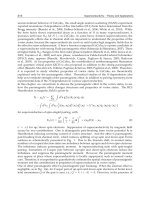Superconductivity Theory and Applications Part 1 pot
Bạn đang xem bản rút gọn của tài liệu. Xem và tải ngay bản đầy đủ của tài liệu tại đây (529.22 KB, 25 trang )
SUPERCONDUCTIVITY
– THEORY AND
APPLICATIONS
Edited by Adir Moysés Luiz
Superconductivity – Theory and Applications
Edited by Adir Moysés Luiz
Published by InTech
Janeza Trdine 9, 51000 Rijeka, Croatia
Copyright © 2011 InTech
All chapters are Open Access articles distributed under the Creative Commons
Non Commercial Share Alike Attribution 3.0 license, which permits to copy,
distribute, transmit, and adapt the work in any medium, so long as the original
work is properly cited. After this work has been published by InTech, authors
have the right to republish it, in whole or part, in any publication of which they
are the author, and to make other personal use of the work. Any republication,
referencing or personal use of the work must explicitly identify the original source.
Statements and opinions expressed in the chapters are these of the individual contributors
and not necessarily those of the editors or publisher. No responsibility is accepted
for the accuracy of information contained in the published articles. The publisher
assumes no responsibility for any damage or injury to persons or property arising out
of the use of any materials, instructions, methods or ideas contained in the book.
Publishing Process Manager Mirna Cvijic
Technical Editor Teodora Smiljanic
Cover Designer Jan Hyrat
Image Copyright Zhuda, 2010. Used under license from Shutterstock.com
First published June, 2011
Printed in Croatia
A free online edition of this book is available at www.intechopen.com
Additional hard copies can be obtained from
Superconductivity – Theory and Applications, Edited by Adir Moysés Luiz
p. cm.
ISBN 978-953-307-151-0
free online editions of InTech
Books and Journals can be found at
www.intechopen.com
Contents
Preface IX
Chapter 1 Room Temperature Superconductivity 1
Adir Moysés Luiz
Chapter 2 Unconventional Superconductivity Realized Near
Magnetism in Hydrous Compound Na
x
(H
3
O)
z
CoO
2
· yH
2
O 15
Yoshihiko Ihara and Kenji Ishida
Chapter 3 Coherent Current States in Two-Band Superconductors 37
Alexander Omelyanchouk
Chapter 4 Nonlinear Response of the Static and
Dynamic Phases of the Vortex Matter 55
S. S. Banerjee, Shyam Mohan, Jaivardhan Sinha,
Yuri Myasoedov, S. Ramakrishnan and A. K. Grover
Chapter 5 Energy Dissipation Minimization
in Superconducting Circuits 85
Supradeep Narayana and Vasili K. Semenov
Chapter 6 Electronic Transport in an NS System with a Pure Normal
Channel - Coherent and Spin-Dependent Effects 99
Yu. N. Chiang (Tszyan)
Chapter 7 Effects of Impurities on a Noncentrosymmetric
Superconductor - Application to CePt
3
Si 129
Heshmatollah Yavari
Chapter 8 Foundations of Meissner Superconductor
Magnet Mechanisms Engineering 153
Jose Luis Perez-Diaz and Efren Diez-Jimenez
Chapter 9 Properties of Macroscopic Quantum Effects
and Dynamic Natures of Electrons in Superconductors 173
Pang Xiao-feng
VI Contents
Chapter 10 FFLO and Vortex States in Superconductors
with Strong Paramagnetic Effect 213
M. Ichioka, K.M. Suzuki, Y. Tsutsumi and K. Machida
Chapter 11 Development of Josephson Voltage Standards 239
Johannes Kohlmann and Ralf Behr
Chapter 12 Critical State Analysis Using Continuous
Reading SQUID Magnetometer 261
Zdeněk Janu, Zdeněk Švindrych,
Ahmed Youssef and Lucia Baničová
Chapter 13 Current Status and Technological Limitations of Hybrid
Superconducting-normal Single Electron Transistors 279
Giampiero Amato and Emanuele Enrico
Chapter 14 Photonic Band Structure and Transmittance
of the Superconductor Photonic Crystal 301
Ting-Hang Pei and Yang-Tung Huang
Chapter 15 Electrodynamics of High Pinning Superconductors 329
Klimenko E.Yu.
Preface
Superconductivity was discovered 1911 by Kamerlingh Onnes. During the last centu-
ry, the history of superconductivity has been full of theoretical challenges and practi-
cal developments. In 1986, the discovery of Bednorz and Müller of an oxide supercon-
ductor with critical temperature (Tc) approximately equal to 35 K, has given a novel
impetus to this fascinating subject. Since this discovery, there are a great number of la-
boratories all over the world involved in research of superconductors with high Tc
values, the so-called “high-Tc superconductors”. The discovery of a room temperature
superconductor has been a long-standing dream of many scientists. The technological
and practical applications of such a discovery should be tremendous. However, the ac-
tual use of superconducting devices is limited by the fact that they must be cooled to
low temperatures to become superconducting. Until 2011, one hundred years after the
first Kamerlingh Onnes' discovery, the highest Tc value is approximately equal to 135
K at 1 atm. The knowledge of the microscopic mechanisms of high-Tc superconductors
should be a theoretical guide in the researches of room temperature superconductivity.
This book contains 15 chapters reporting interesting researches about theoretical and
experimental aspects of superconductivity. Here you will find a great number of
works containing theories and describing properties of high-Tc superconductors (ma-
terials with Tc > 30 K). In a few chapters there are also discussions about low-Tc super-
conductors (materials with Tc < 30 K).
The plan of this book is:
Chapter 1 contains theoretical discussions about the possibility of room temperature
superconductivity.
In the chapters 2, 3, 4 and 5 are discussed interesting theories about physical proper-
ties of superconductors.
Chapter 6 presents report about the electronic transport in an NS system with a pure
normal channel.
In chapter 7 can be found a theoretical discussion concerning the effects of impurities
on a noncentrosymmetric superconductor.
X Preface
Chapter 8 contains a research about the Meissner effect and the use of superconduc-
tors as magnets.
Chapter 9 is a report about the properties of macroscopic quantum effects in super-
conductors.
Chapter 10 presents theoretical discussions concerning the vortex state of supercon-
ductors.
In Chapter 11 the development of Josephson voltage standards is analyzed.
Chapter 12 contains critical state analysis using a SQUID magnetometer.
Chapter 13 is a theoretical discussion about superconducting transistors.
Chapter 14 presents some physical properties of the superconductor photonic crystal.
Finally, in chapter 15 you can find a theoretical discussion about the electrodynamics
of high pinning superconductors.
I expect that this book will be useful to encourage further experimental and theoretical
research of superconductivity.
Adir Moysés Luiz
Instituto de Física, Universidade Federal do Rio de Janeiro
Brazil
1
Room Temperature Superconductivity
Adir Moysés Luiz
Instituto de Física, Universidade Federal do Rio de Janeiro
Brazil
1. Introduction
Superconductivity was discovered by Kamerlingh Onnes in 1911. For one century
superconductivity has been a great challenge to theoretical physics. The first successful set of
phenomenological equations for superconducting metals was given by F. London in 1935. Yet,
in 1950, almost 40 years after the discovery of this phenomenon, there was not any adequate
microscopic theory of superconductivity. However, by 1935, single elements necessary to a
successful theory to explain superconductivity was known to theorists. The peculiar
condensation of a Bose-Einstein gas was predicted by Einstein in 1925. The idea that pairs of
fermions can combine to form bosons has been known since 1931. In 1950 the most relevant
ideas of superconductivity has been summarized by F. London in his famous book
“Superfluids”, volume 1. At last, BCS theory (Bardeen et al., 1957) was the first successful
theory to explain the microscopic mechanisms of superconductivity in metals and alloys.
Practical applications of superconductivity are steadily improving every year. However, the
actual use of superconducting devices is limited by the fact that they must be cooled to low
temperatures to become superconducting. For example, superconducting magnets used in
most particle accelerators are cooled with liquid helium, that is, it is necessary to use
cryostats that should produce temperatures of the order of 4 K. Helium is a very rare and
expensive substance. On the other hand, because helium reserves are not great, the world's
supply of helium can be wasted in a near future. Thus, because liquid nitrogen is not
expensive and the reserves of nitrogen could not be wasted, it is important to use high-T
c
superconductors cooled with liquid nitrogen. Superconductors with critical temperatures
greater 77 K may be cooled with liquid nitrogen.
We know that BCS theory (Bardeen et al., 1957) explains the microscopic mechanisms of
superconductivity in metals. According to BCS theory, electrons in a metallic
superconductor are paired by exchanging phonons. According to many researchers (De
Jongh, 1988; Emin, 1991; Hirsch, 1991; Ranninger, 1994), BCS theory is not appropriate to be
applied to explain the mechanisms of superconductivity in oxide superconductors.
Nevertheless, other models relying on a BCS-like picture replace the phonons by another
bosons, such as: plasmons, excitons and magnons, as the mediators causing the attractive
interaction between a pair of electrons and many authors claim that superconductivity in
the oxide superconductors can be explained by the conventional BCS theory or BCS-like
theories (Canright & Vignale, 1989; Tachiki & Takahashi, 1988; Takada, 1993).
Copper oxide superconductors are the most important high-T
c
superconductors. The
discovery of a room temperature superconductor should trigger a great technological
Superconductivity – Theory and Applications
2
revolution. There are claims of synthesis of a room temperature superconductor (see, for
example, www.superconductors.org, 2011). But these claims are not accepted by the
scientific community. It is generally accepted in the scientific literature that the highest T
c
is
approximately equal to 135 K at 1 atm in the Hg-Ba-Ca-Cu-O system (Schilling & Cantoni,
1993). However, T
c
in this system can be raised up to 180 K using high external pressures.
We believe that the discovery of a room temperature superconductor would be possible
only when the microscopic mechanisms of oxide superconductors should be clarified.
However, up to the present time, the microscopic mechanisms responsible for high-T
c
superconductivity are unclear. In a recent article (Luiz, 2010), we have discussed a simple
model to study microscopic mechanisms in high-T
c
superconductors. The objective of this
chapter is to present new studies in order to give new theoretical support for that simple
model. We also discuss the possibility of room temperature superconductivity.
2. Possibility of room temperature superconductivity
It is well known that the superconducting state is characterized by a quantum macroscopic
state that arises from a Bose-Einstein condensation (BEC) of paired electrons (Cooper pairs).
Initially, it is convenient to clarify some concepts regarding BEC. It is well known that a
collection of particles (bosons) that follows the counting rule of Bose-Einstein statistics
might at the proper temperature and density suddenly populate the collections ground state
in observably large numbers (Silvera, 1997). The average de Broglie wavelength
dB
which is
a quantum measurement of delocalization of a particle, must satisfy this condition. We
know that
dB
= h/p, where h is Planck’s constant and p is the momentum spread or
momentum uncertainty of the wave packet. In the other extreme, for particles in the zero
momentum eigenstate, the delocalization is infinite; i.e., the packet is spread over the entire
volume V occupied by the system. It is generally accepted that BEC occurs when the
interparticle separation is of the order of the delocalization
dB
(Silvera, 1997).
The thermal de Broglie wavelength
dB
is a measure of the thermodynamic uncertainty in
the localization of a particle of mass M with the average thermal momentum. Thus,
dB
is
given by
dB
= h/[3MkT]
1/2
(1)
where k is Boltzmann’s constant. Equation (1) shows that at a certain low temperature T
or/and for a small mass M,
dB
may be spread over great distances. In order to determine
the critical temperature T
c
at which the addition of more particles leads to BEC it is sufficient
to calculate a certain critical density n = N/V, where N is the number of bosons. This
calculation is performed using Bose-Einstein statistics; according to (Silvera, 1997) and
considering the mass of the boson (Cooper pair) M = 2m*, where m* is the effective mass of
the electron, we obtain
T
c
= 3.31h
2
n
2/3
/(4
2
kM) (2)
The first application of BEC theory to explain
4
He superfluidity was realized in 1938
(London, 1938). In an important paper (Blatt, 1962), the BEC approach has been extended to
give the same results predicted by BCS theory. Thus, it is reasonable to conclude that the
conventional n-type superconductivity in metals (explained by BCS theory) is a special case
that can also be considered as a phenomenon of BEC of Cooper pairs.
Room Temperature Superconductivity
3
There are three possibilities of occurrence of BEC: (a) BEC involving just bosons, (b) BEC
involving just fermions, and (c) BEC involving bosons and fermions simultaneously. In (a)
there is a direct BEC without the need of an interaction to bind the bosons. However, in the
cases (b) and (c) BEC is possible only indirectly in two steps: in the first step it occurs the
binding between pairs of fermions giving rise to bosons and, in the second step, BEC of
these bosons may occur.
Because liquid
4
He is a system of bosons, the condensation of
4
He is a BEC of type (a).
Superfluidity of
3
He (Lee, 1997) is an example of BEC of type (b). Because liquid
3
He is a
system of fermions, in order to occur BEC, two particles must be binded to form a boson
and, in he next step, a BEC of these bosons may occur. Another example of BEC of type
(b) is the phenomenon of superconductivity in metals and alloys. In the last case, BCS
theory (Bardeen et al., 1957) is a successful theory to explain the microscopic mechanisms
of superconductivity in metals, and in this case, Equation (2) is not appropriate to
calculate the critical temperature T
c
because we cannot predict the density n of the bosons
formed exchanging phonons. In BCS theory, the critical temperature T
c
is the temperature
at which a great number of Cooper pairs are formed by exchanging phonons. When the
density n of pairs formed are sufficiently high it is possible to occur a Bose-Einstein
condensation. For example, in pure copper the density n of Cooper pairs formed are not
sufficiently high, thus pure copper cannot become superconductor even at temperatures
in the neighborhood of 0 K.
We study now the possibility of occurrence of a Bose-Einstein condensation in an oxide
material. If possible, this phenomenon should be a BEC of type (c) just mentioned, that is,
the mechanism should involve bosons and fermions simultaneously. In order to verify if
BEC is possible in oxide superconductors, it is sufficient to calculate the order of magnitude
of the critical temperature T
c
using Equation (2). According to Table 1 in the reference (De
Jongh, 1988), in a p-type copper oxide superconductor, a typical order of magnitude of the
carrier density is given by n = 10
21
/cm
3
. Considering an effective mass m* = 12m, where m
is the rest mass of the electron, we obtain by Equation (2) the following approximated value:
T
c
= 100 K. This calculation is very crude because Equation (2) is based on an isotropic
model of an ideal Bose gas. However, oxide superconductors are not isotropic; on the other
hand, pair of electrons (bipolarons) in oxide materials are not an ideal Bose gas because we
must consider Coulomb interactions. But the crude calculation based on Equation (2) is
sufficient to show that BEC in oxide superconductors cannot be ruled out. A more
appropriate formula to calculate T
c
(supposing BEC) has been derived in (Alexandrov &
Edwards, 2000).
On the basis of the crude calculation based on Equation (2) we will now discuss the
possibility of room temperature superconductivity. Using the same above mentioned values
and considering a carrier density greater than n = 10
21
/cm
3
we conclude that the critical
temperature T
c
could be enhanced. For example, considering m* = 12m and a carrier density
n = 3 10
21
/cm
3
, we obtain a critical temperature T
c
= 300 K. Thus, if we apply Equation (2),
it is reasonable to conclude that room temperature superconductivity is possible.
According to the type of charge carriers, superconductors can be classified in two types: n-
type superconductors, when the charge carriers are Cooper pairs of electrons and p-type
superconductors, when the charge carriers are Cooper pairs of holes.
We claim that only p-type materials should be considered in the researches to synthesize a
room temperature superconductor. We claim that n-type materials are not qualified to
obtain a room temperature superconductor, because in an n-type material the carriers are
Superconductivity – Theory and Applications
4
electrons and these electrons should be binded in order to form bosons. On the other hand,
due to Coulomb interactions, it is very difficult to accept a situation of an ideal Bose gas of
electrons pairs in order to apply Equation (2). However, considering p-type materials, there
are two types of interactions: Coulomb repulsions between electrons, but Coulomb
attractions between electrons and holes. Thus, it is reasonable to accept an approximation
considering an ideal Bose gas of Cooper pairs of holes in order to apply Equation (2). On the
other hand, Bose-Einstein condensation is not restricted only to an ideal Bose gas of bosons
(Blatt, 1962). The phenomenon of Bose-Einstein condensation could also be extended to a
real Bose gas. It is worthwhile to develop a complete theory to extend the predictions of BEC
to a real Bose gas. A fermion-boson mixture of unpaired electrons coexisting and interacting
with Cooper pairs treated as real two-electrons and two-holes has been proposed in a letter
(Tolmachev, 2000). Finally, considering the simple calculation based on Equation (2) we
conclude that the possibility of room temperature superconductivity cannot be ruled out.
3. Superconductors containing oxygen
The most relevant metallic superconductors are pure metals and alloys. BCS theory is
appropriate to explain the microscopic mechanisms of superconductivity in pure metals and
alloys. However, a great number of oxide materials may become non-metallic
superconductors. It seems that BCS theory is not appropriate to explain the microscopic
mechanisms in superconductors containing oxygen. An interesting review about oxide
superconductors is found in the references (Cava, 2000). The history of oxide
superconductors begins in 1933 with the synthesis of the superconductor NbO; with T
c
= 1.5
K (Sleight, 1995). In 1975 it was discovered the oxide superconductor BaPb
0.7
Bi
0.3
O
3
(Sleight
et al., 1975) with T
c
= 13 K.
Superconductor Year T
C
Reference
NbO 1933 1.5 Sleight, 1995
K
x
WO
3
1967 6.0 Remeika et al., 1967
LiTi
2 + x
O
4
1973 1.2 Johnston et al., 1973
BaPb
1 -
x
Bi
x
O
3
1975 13 Sleight et al., 1975
La
2 -
x
Ba
x
CuO
4
1986 30 Bednorz & Müller, 1986
YBa
2
Cu
3
O
7 -
x
1987 90 Wu et al., 1987
Ba
1 -
x
K
x
BiO
3
1988 30 Cava et al.,1988
BiSrCaCu
2
O
6 + x
1988 105 Maeda et al., 1988
Tl
2
Ba
2
Ca
2
Cu
3
O
9 + x
1988 110 Shimakawa et al., 1988
HgBa
2
Ca
2
Cu
3
O
8 + x
1993 130 Schilling & Cantoni, 1993
NdFeAsO
1-x
2008 54 Yang et al., 2008
Table 1. List of the most relevant superconductors containing oxygen in chronological order.
In 1986, the oxide superconductor Ba
0.15
La
1.85
CuO
4
with T
c
= 30 K has been discovered
(Bednorz & Müller, 1986). The expression “high-T
c
superconductors” has been generally
used in the literature to denote superconductors with critical temperatures higher than 30 K.
After this famous discovery many cuprate high-T
c
superconductors have been synthesized.
The cuprate superconductor HgBa
2
Ca
2
Cu
3
O
8 + x
(Hg-1223) has the highest critical
temperature (T
c
= 135 K) at 1 atm (Schilling & Cantoni, 1993). In 2008, a new type of high-T
c
Room Temperature Superconductivity
5
superconductor containing iron (without copper) has been discovered (Yang et al., 2008). In
Table 1, we list in chronological order the most important discoveries of superconductors
containing oxygen. In Table 1, T
c
is expressed in Kelvin and x is a variable atomic fraction of
the doping element.
4. Valence skip and double valence fluctuations
What is the principal feature observed in all superconductors listed in Table 1? It is easy to
verify that all metals used in the synthesis of superconductors containing oxygen have
mixed oxidation states. For example, we can verify that in the superconductor NbO, Nb may
have the oxidation states Nb(+III) and Nb(+V). In the bronze superconductor K
x
WO
3
, W
may have the oxidation states W(+IV) and W(+VI). In the superconductor LiTi
2 + x
O
4
, Ti may
have the oxidation states Ti(+II) and Ti(+IV). In the superconductor BaPb
1 - x
Bi
x
O
3
, Pb may
have the oxidation states: Pb(+II) and Pb(+IV) and Bi may have the oxidation states Bi(+III)
and Bi(+V). Finally, we verify that in the copper oxide superconductors listed in Table 1, Cu
may have the oxidation states Cu(+I) and Cu(+III).
Note also that in the superconductor NdFeAsO
1-x
, an example of the recent discovery of
iron-based superconductors (Yang et al., 2008), we can verify that Fe may have the oxidation
states Fe(+II) and Fe(+IV) and As may have the oxidation states As(+III) and As(+V).
According to a number of authors the probable existence of double charge fluctuations in
oxide superconductors is very likely (Callaway et al., 1987; Foltin, 1988; Ganguly & Hegde,
1988; Varma, 1988). Spectroscopic experiments (Ganguly & Hegde, 1988), indicate that
double charge fluctuations is a necessary, but not sufficient, criterion for superconductivity.
We argue that these charge fluctuations should involve paired electrons hoping from ions
(or atoms) in order to occupy empty levels. That is, our basic phenomenological hypothesis
is that the electrons involved in the hopping mechanisms might be paired electrons coming
from neighboring ions or neighboring atoms.
The discovery of Fe-based high-T
c
superconductors (Yang et al., 2008) has reopened the
hypothesis of spin fluctuations for the microscopic mechanisms of high-T
c
superconductivity. However, it is interesting to note that Fe may have the oxidation states
Fe(+II) and Fe(+IV). Thus, the conjecture of double charge fluctuations cannot be ruled out
in the study of the microscopic mechanisms in all Fe-based high-T
c
superconductors. It is
worthwhile to study the competition between double charge fluctuations and spin
fluctuations in order to identify which phenomenon is more important in the microscopic
mechanisms responsible for the condensation of the superconducting state of Fe-based
materials.
What is valence skip? About fifteen elements in the periodic table skip certain valences in all
compounds they form. For example, it is well known that the stable oxidation states of
bismuth are Bi(+III) and Bi(+V). The oxidation state Bi(+IV) is not stable. If the state Bi(+IV)
is formed, it occurs immediately a disproportionation, according to the reaction: 2Bi(+IV) =
Bi(+III) + Bi(+V). In the compound BaBiO
3
, the formal valence Bi(+IV) is understood as an
equilibrium situation involving a mixture of equal amounts of the ions Bi(+III) and Bi(+V).
Other important examples of elements with valence skip are As, Pb and Tl. In (Varma, 1988)
there is an interesting discussion about the microscopic physics responsible for the
phenomenon of valence skip. The electronic states of valence-skipping compounds are
described in a conference paper (Hase & Yanagisawa, 2008). Elements with valence skip,
like Bi and Pb, are the most appropriate elements to study the hypothesis of double charge
Superconductivity – Theory and Applications
6
fluctuations proposed in this chapter. It has been claimed that all elements with valence skip
may be used in the synthesis of superconductors (Varma, 1988).
5. Oxygen doping by diffusion
The most relevant doping procedures used for the synthesis of cuprate superconductors
have been described in a review article (Rao et al., 1993). Historically, the first synthesis of a
high-T
c
oxide superconductor was the copper oxide Ba
x
La
2-x
CuO
4
(Bednorz & Muller, 1986).
This superconductor is synthesized by doping the parent material La
2
CuO
4
with Ba atoms.
Soon after this discovery, it was realized (Schirber et al., 1988) that doping the parent
material La
2
CuO
4
with oxygen, without the introduction of any Ba atomic fraction x, it is
also possible to synthesize the superconductor La
2
CuO
4+x
. Thus, in this case, we conclude
that the introduction of oxygen is responsible for the doping mechanism of the parent
material La
2
CuO
4
(Schirber et al., 1988).
Oxide materials may become superconductors when a parent material is doped by the
traditional doping mechanism with cation substitution or by a doping mechanism based on
oxygen nonstoichiometry (De Jongh, 1988). If a certain oxide contains a metal with mixed
oxidation numbers, by increasing (or decreasing) the oxygen content, the metal may be
oxidized (or reduced) in order to maintain charge neutrality. Therefore, the synthesis of p-
type superconductors may be obtained by doping the parent materials with an excess of
oxygen atoms and the synthesis of n-type superconductors may be obtained by doping the
parent materials with a deficiency of oxygen atoms.
The most famous example of oxygen doping is provided by the family of p-type oxide
superconductors Y-Ba-Cu-O. It is well known that YBa
2
Cu
3
O
6+x
, considering compositions x
between x = 0.5 and x = 0.9, are superconductors, and with a maximum T
c
corresponding to
a composition x = 0.9. An important example of n-type superconductor is provided by the
recent discovery of the superconductor GdFeAsO
1-x
, a high-T
c
superconductor with oxygen-
deficiency; it has been shown that oxygen doping is a good and reliable procedure for the
synthesis of a new family of iron-based high-T
c
superconductors (Yang et al., 2008).
In the present chapter we shall study only oxygen doping of p-type oxide superconductors.
It is well known that high-T
c
superconductors are generally synthesized when a parent
material is doped by the traditional doping mechanism with cation (or anion) substitution.
But it seems that doping mechanisms based on oxygen nonstoichiometry are more
appropriate than doping mechanisms based on cation (or anion) substitutions. However,
doping mechanisms based on oxygen nonstoichiometry are not completely clear. In this
chapter we give some ideas to study the microscopic mechanisms associated with oxygen
doping of p-type oxide superconductors.
A normal atmosphere contains about 21% of O
2
, 78% of N
2
, and 1% of other gases. Consider
an oxide material. When it is heated in a furnace containing atmospheric air at ambient
pressure or containing an oxygen reach atmosphere, due to diffusion, some O
2
molecules
may be absorbed in the bulk of the solid material. Thus, oxygen nonstoichiometry is a
necessary consequence of heating processes of oxide materials submitted to ambient
pressure or submitted to atmospheres containing an oxygen excess. The diffusion of oxygen
in binary metal oxides has been studied in a book (Kofstad, 1983).
According to molecular orbital (MO) theory (Petrucci et al., 2000), to obtain the molecular
orbital electronic configuration of O
2
molecule it is necessary to combine the atomic orbitals
of two O atoms. We obtain the following molecular orbital electronic configuration of O
2
molecules:
Room Temperature Superconductivity
7
[MO configuration of O
2
]: [inner electrons](
2s
)
2
(*
2s
)
2
(
2p
)
4
(
2p
)
2
(*
2p
)
2
Considering the above MO configuration of O
2
we conclude that there are two unpaired
electrons in the orbital *
2p
. By diffusion and solid state reaction, O
2
molecules may oxidize
metal atoms or ions in the bulk material. Because there are two unpaired electrons, the O
2
molecule may pick two electrons in the neighboring metal ions, becoming a peroxide ion
O
2
(-II) species. Our hypothesis of formation of peroxide ion species in oxide
superconductors is supported by a great number of spectroscopic measurements (Rao et al.,
1987; Sarma et al., 1987; Dai et al., 1988; Mehta et al., 1992).
In order to understand the microscopic mechanisms of oxygen doping, we give an example.
Consider an oxide material containing bismuth (without copper); for instance, consider
BaBiO
3
. As we have stressed in Section 4, the bismuth stable oxidation states are Bi(+III) and
Bi(+V). When an oxygen molecule reacts with a Bi(+III) ion, it is reasonable to suppose that
this ion gives two electrons to the O
2
molecule, that is, we may write the following reaction:
O
2
+ Bi(+III) O
2
(-II) + Bi(+V)
Considering this oxidation reaction we conclude that the formation of the peroxide species
O
2
(-II) corresponds to the creation of a double hole. In many oxide compounds the electrons
or holes may be considered to be localized at lattice atoms forming lattice defects. In such a
case, we may suppose that p-type conduction may involve hopping of electrons from site to
site (Kofstad, 1983). Therefore, in the bismuth example just mentioned, we claim that
conductivity (and superconductivity) may be explained by hopping of electron pairs that
jump from neighboring sites to occupy hole pairs.
It is well known that for p-type superconductors the optimal oxygen doping of high-T
c
oxide superconductors corresponds to a certain critical hole content. An under-doped
superconductor is synthesized when the hole content is less than this critical value and an
over-doped superconductor is synthesized when the hole content is greater than this critical
value. The prediction of the optimal doping is an unresolved issue. In the next Section we
propose a simple model to estimate the optimal doping of p-type oxide superconductors.
6. Optimal doping of p-type oxide superconductors containing bismuth
without copper
Our basic hypothesis is that the existence of double charge fluctuations involving paired
electrons may be a key to study the microscopic mechanisms in oxide superconductors. The
essential concept in this hypothesis is that the hopping mechanism involves two paired
electrons, instead of the hopping of a single electron. Our hypothesis may be easily applied
in the oxide superconductors containing Bi (without Cu) because, in this case, it is well
known that Bi (+III) and Bi (+V) are the only stable oxidation states for the Bi ions. Thus,
double charge fluctuations may occur between the ions Bi (+III) and Bi (+V). In this Section
we propose a simple method to calculate the optimal doping of oxide superconductors
containing bismuth without copper and in the next Section we consider oxide
superconductors containing copper without bismuth.
What should be the ideal chemical doping of oxide p-type superconductors containing
bismuth without copper in order to obtain the maximum value of T
c
? This optimal doping
should be obtained by cation substitution or by increasing the oxygen content in the
material.
Superconductivity – Theory and Applications
8
Let us first suppose equal amounts of the ions Bi (+III) and Bi (+V). In this case the formal
oxidation state of bismuth should be Bi (+IV). Thus, charge fluctuations should be balanced
and the formation of holes is very difficult.
For example, it is well known that BaBiO
3
is an insulator because in this material the formal
oxidation state of bismuth is Bi (+IV). However, by doping BaBiO
3
by cation substitution or
by increasing the oxygen content a superconductor may be obtained. Chemical doping may
destroy the balance between the ions Bi (+III) and Bi (+V). If the ions Bi (+V) are increased, it
is possible to create holes. It is reasonable to suppose that the maximum concentration for
optimal doping should correspond to a ratio [(Bi(+V) ions)/(Bi(+III) ions)] = 2, that is, the
optimal concentration of the ions Bi (+V) should be the double of the concentration of the
ions Bi (+III). Why we have proposed the ratio [(Bi(+V) ions)/(Bi(+III) ions)] = 2 for optimal
doping? It is well known that T
c
decreases when the hole concentration is higher than a
certain critical concentration (Zhang & Sato, 1993). This important property is the
nonmonotonic dependence of T
c
on the carrier concentration, a high-T
c
characteristic feature
of all oxide superconductors. If the concentration of the ions Bi (+V) are further increased
(and the concentration of the ions Bi (+III) are further decreased), the material becomes
overdoped and T
c
decreases. Thus, for optimal doping, the bismuth ion concentrations
should be: (2/3)Bi (+V) and (1/3)Bi (+III). In the next section we propose an analogous
simple model to estimate the optimal doping of p-type copper oxide superconductors
(without bismuth).
Now we apply the above simple model to estimate the optimal doping of p-type oxide
superconductors containing bismuth without copper. As an example, we apply our
hypothesis to the material Ba
0.6
K
0.4
BiO
x
, a famous oxide superconductor without copper,
with T
c
approximately equal to 30 K (Cava et al., 1988).
We shall suppose for the Bi ions the proportionality assumed in the model just suggested,
that is, for optimal doping, we assume that the relative concentrations should be given by:
(2/3)Bi(+V) and (1/3)Bi(+III). Considering the oxidation states Ba(+II) and K(+I) and using
the charge neutrality condition, we have:
1.2 + 0.4 + (1/3)(3) + (2/3)(5) – 2x = 0 (3)
From Equation (3) we obtain the result:
x = 2.97 (4)
The result (4) is in good agreement with the value (x = 3) reported in the reference (Cava et
al., 1988).
In the next section we extend the simple model just proposed to estimate the optimal doping
of p-type oxide superconductors containing copper without bismuth.
7. Optimal doping of p-type oxide superconductors containing copper
without bismuth
To apply our hypothesis to a copper oxide superconductor (without Bi) it should be
necessary to suppose the existence of Cu (+I) because we are assuming double charge
fluctuations between the states Cu(+I) and Cu(+III). In p-type Cu oxide superconductors,
the existence of the oxidation state Cu(+III) is obvious by the consideration of charge
neutrality. Thus, from an experimental point of view, it is very important to verify if the
Room Temperature Superconductivity
9
oxidation state Cu(+I) is present in the high-T
c
Cu oxide superconductors. The probable
existence of the states Cu(+I) and Cu(+III) has been verified in the works (Karppinen et al.,
1993; Sarma & Rao, 1988).
It is generally believed that the microscopic mechanisms in a cuprate superconductor
depends only on the ions Cu(+II) and Cu(+III), without the presence of the ions Cu(+I).
Let us suppose that the hopping mechanism involves just a single electron between
Cu(+II) and Cu(+III); if this single charge fluctuation would be responsible for
superconductivity, we should conclude that the enhancement of Cu(+III) ions should
produce a continuous enhancement of the critical temperature T
c
. However, it is well
known that T
c
decreases when the hole concentration is higher than a certain
concentration (Zhang & Sato, 1993). This important property is the nonmonotonic
dependence of T
c
on the carrier concentration, a high-T
c
characteristic feature of all oxide
superconductors. Thus, by this reasoning and considering the experimental results
(Karppinen et al., 1993; Sarma & Rao, 1988), we can accept the presence of the mixed
oxidation states Cu(+I), Cu(+II) and Cu(+III) in the copper oxide superconductors. On the
other hand, this conjecture is supported if we consider the copper disproportionation
reaction (Raveau et al, 1988): 2Cu(+II) = Cu(+I) + Cu(+III).
What should be the optimal chemical doping of Cu oxide superconductors in order to obtain
the maximum value of T
c
? Initially, considering the disproportionation reaction (Raveau et
al, 1988): 2Cu(+II) = Cu(+I) + Cu(+III), we may suppose an equal probability for the
distribution of the copper ions states Cu (+I), Cu (+II) and Cu (+III). Thus, the initial
concentrations of these ions should be (1/3)Cu(+I), (1/3)Cu(+II) and (1/3)Cu(+III).
However, we may suppose that by oxidation reactions, (1/3)Cu(+II) ions may be completely
converted to (1/3)Cu(+III) ions. In this case, the maximum concentration of the Cu(+III) ions
should be: (1/3) + (1/3) = (2/3). Thus, the optimal doping should correspond to the
following maximum relative concentrations: (1/3)Cu(+I) ions and (2/3)Cu(+III) ions. That
is, the optimal doping, should be obtained supposing the following concentration ratio:
[(Cu(+III) ions)/(Cu(+I) ions)] = 2.
We apply this hypothesis to estimate the optimal doping of the famous cuprate
superconductor YBa
2
Cu
3
O
x
, where x is a number to be calculated. Using the relative values:
(1/3) for Cu(+I) ions and (2/3) for Cu(+III) ions, we may write the formula unit:
YBa
2
Cu
1
(+I)Cu
2
(+III)O
x
. Considering the oxidation states Y(+III), Ba(+II) and O(-II) and
using the charge neutrality condition, we get:
3 + (2 2) + (1 1) + (2 3) – 2x = 0 (5)
From Equation (5) we obtain:
x = 7.0 (6)
The result (6) is in good agreement with the result (x = 6.9) reported in (Kokkallaris et al.,
1999).
Using the simple model just described, we estimate the necessary oxygen content to
obtain the optimal doping of the most relevant p-type cuprate superconductors. It is
important to note that the experimental determination of the oxygen content is a very
difficult task. In Table 2 we have selected a number of works containing this experimental
information.
Superconductivity – Theory and Applications
10
Superconductor Predicted Measured REFERENCE
Ba
0.15
La
1.85
CuO
x
x = 4.1 x = 4.0 Bednorz & Müller, 1986
La
2
CuO
x
x = 4.2 x = 4.1 Schirber et al., 1988
YBa
2
Cu
3
O
x
x = 7.0 x = 6.9 Kokkallaris et al.,1999
YBa
2
Cu
4
O
x
x = 8.2 x = 8.0 Rao et al., 1993
Sr
2
CuO
x
x = 3.17 x = 3.16 Hiroi et al., 1993
HgBa
2
Ca
2
Cu
3
O
x
x = 8.5 x = 8.4 Hung et al., 1997
Table 2. Comparison between the values of oxygen content of copper oxide superconductors
(not containing Bi) predicted by our simple model and the experimental values reported in
the literature.
According to our model, we have used for the copper ions the following relative values:
(1/3) for Cu(+I) ions and (2/3) for Cu(+III) ions. For the other elements in Table 2, we have
considered the following stable oxidation states: La(+III), Y(+III), Ba(+II), Sr(+II), Ca(+II),
Hg(+II) and O(-II). We verify that the results predicted by the simple model proposed here
are in good agreement with the experimental results listed in Table 2.
8. Discussion
We believe that the simple model proposed in this paper in the case of p-type oxide
superconductors could also be extended to estimate the optimal doping of n-type oxide
superconductors. However, in the case of n-type oxide superconductors, the reaction
produced by oxygen doping is a reduction reaction instead of an oxidation reaction that
occurs in p-type oxide superconductors. Since we have not found in the literature any
experimental determination of the oxygen content in the case of n-type oxide
superconductors we shall not discuss this issue here. This question will be addressed in a
future work.
We have proposed a simple model to estimate the relative concentrations of the ions
involved to estimate the oxygen content for optimal doping of p-type oxide
superconductors. The predictions based on this model are in good agreement with
experimental results reported in the literature (Table 2). However, we emphasize that the
model proposed in this chapter is not a complete theoretical model, it is just a simple
phenomenological model.
Our conjectures can be used to explain some remarkable properties of high-T
c
superconductors: (a) the anisotropy is explained considering that the electrons involved in
the hopping mechanisms are 3d-electrons (in the case of copper oxide superconductors); (b)
the order of magnitude of the coherence length (the mean distance between two electron
pairs) is in accordance with the order of magnitude of the distance between the electron
clouds of two neighboring ions; (c) the nonmonotonic dependence of T
c
on the carrier
concentration is explained by the hypothesis of double charge fluctuations and the optimal
doping model proposed in this chapter.
The theory of bipolaronic superconductivity (Alexandrov & Edwards, 2000) is similar to our
phenomenological model. In the theory of bipolaronic superconductivity, bipolarons are
formed supposing a mechanism to bind two polarons. However, by our hypothesis, it is not
necessary to suppose the formation of bipolarons by the binding of two polarons. We have
assumed that the preformed pairs are just pairs of electrons existing in the electronic
Room Temperature Superconductivity
11
configurations of the ions or atoms involved in double charge fluctuations. These pairs
should be, for example, lone pairs in atoms or ions or pairs of electrons in the electronic
configurations obtained when Hund’s rule is applied.
9. Concluding remarks
In this chapter we have studied the most relevant questions about the microscopic
mechanisms of superconductivity in oxide materials. Parts of our arguments may be found
in the list of references in the next Section. However, we believe that our ideas have been
expressed in a clear form for the questions at hand.
The simple model described here is not a theoretical model and cannot be used to account
quantitatively for the microscopic mechanisms responsible for superconductivity in oxide
materials. However, we believe that our assumptions are helpful to the investigations of the
microscopic mechanisms in oxide superconductors. We expect that this simple model will
also be useful to encourage further experimental and theoretical researches in
superconducting materials. It is worthwhile to study the details of the role of double charge
fluctuations in the microscopic mechanisms responsible for superconductivity in oxide
materials.
We have stressed in Section 2 that in p-type materials there are two types of interactions:
Coulomb repulsions between electrons, but Coulomb attractions between electrons and
holes. Thus, considering the possibility of a Bose-Einstein condensation, we claim that only
p-type materials are qualified to be considered in the researches to obtain a room
temperature superconductor.
Finally, we suggest some future researches. It is worthwhile to make experiments to verify if
this model is correct. Supposing that this simple model works, it would be possible to
calculate stoichiometric compositions in order to obtain the optimal doping in the researches
to synthesize new oxide superconductors. It is well known that the most important method
in semiconductor technology is obtained by ion implantation techniques. Similarly, we
believe that ion implantation techniques probably will be important in superconductor
technology as well. Thus, we hope that future researches based on ion implantation
techniques could open a new route in the synthesis of high-T
c
superconductors. These future
researches, using ion implantation, should take advantage of the possibility of double
charge hoping mechanisms, instead of single charge hoping mechanisms existing in the case
of ion implantation in the semiconductor technology.
10. References
Alexandrov, A. S. & Edwards, P. P. (2000). High T
c
cuprates: a new electronic state of
matter? Physica C, 331, pp. 97-112
Bardeen, J.; Cooper, L. N. & Schrieffer, J. R. (1957). Theory of superconductivity. Phys. Rev. ,
108, 5, pp. 1175-1204
Bednorz, J. G. & Müller, K. A. (1986). Possible high T
c
superconductivity in the Ba-La-Cu-O
system. Zeitschrift fur Physik B, Condensed Matter, 64, 2, pp. 189-193
Blatt, J. M. (1962). Qualitative arguments concerning the Bose-Einstein condensation of
fermion pairs. Progress of Theoretical Physics, 27, pp. 1137-1142
Callaway, J.; Kanhere, D. G & Misra, P. K. (1987). Polarization-induced pairing in high-
temperature superconductivity. Phys. Rev. B, 3, 13, pp. 7141-7144
Superconductivity – Theory and Applications
12
Canright, J. S. & Vignale, G. (1989). Superconductivity and acoustic plasmons in the two-
dimensional electron gas. Phys. Rev. B, 39, 4, pp. 2740-2743
Cava, R. J.; Batlogg, B.; Krajewski, J. J.; Farrow, R.; Rupp Jr, L. W.; White, A. E.; Peck, W. E. &
Kometani, T. (1988). Superconductivity near 30 K without copper: the Ba
0.6
K
0.4
BiO
3
system. Nature, 332, pp. 814-816
Cava, R. J. (2000). Oxide superconductors. Journal American Ceramic Society; 83, 1, pp. 5-28
Dai, Y.; Manthiram, A.; Campion, A. & Goodenough, J. B. (1988). X-ray-photoemission-
spectroscopy evidence for peroxide in 1:2:3 copper oxides containing disordered or
excess oxygen. Physical Review B 38, 7, pp. 5091-5094
De Jongh, L. J. (1988). A comparative study of (bi)polaronic (super)conductivity in high- and
low-T
c
superconducting oxides. Physica C: Superconductivity, 152, pp. 171-216
Emin, D. (1991). Large bipolarons and superconductivity. Physica C: Superconductivity, 185-
189, Part 3, pp. 1593-1594
Foltin, J. (1988). Attractive interaction between electrons: An electron-pairing mechanism for
superconductivity. Phys. Review B, 38, 15, pp. 10900-10902
Ganguly, P. & Hegde, M. S. (1988). Evidence for double valence fluctuation in metallic
oxides of lead. Phys. Rev. B; 37, 10, pp. 5107-5111
Hase, I. & Yanagisawa, T. (2008). Electronic states of valence-skipping compounds. Journal of
Physics: Conference Series, 108, 012011, pp. 1-4
Hiroi, Z.; Takano M.; Azuma, M. & Takeda, Y. (1993). A new family of copper oxide
superconductors Sr
n+1
Cu
n
O
2n+1+
stabilized at high pressure. Nature, 364, 6435, pp.
315-317
Hirsch, J. E. (1991). Bose condensation versus pair unbinding in short-coherence-length
superconductors. Physica C: Superconductivity, 179, pp. 317-332
Hung, K. C.; Lam, C.; Shao, H. M.; Wang, S. D. & Yao, X. X.; (1997). Enhancement in flux
pining and irreversibility field by means of a short time annealing technique for
HgBa
2
Ca
2
Cu
3
O
8.4
superconductor. Superc. Science Technology, 10, 11, pp. 836-842
Johnston, D. C.; Prakash, H.; Zachariessen, W. H. & Vishvanathan, B. (1973) High
temperature superconductivity in the Li-Ti-O ternary system. Materials Research
Bulletin; 8, 7, pp. 777-784
Karppinen, M.; Fukuoca, A.; Wang, J.; Takano, S.; Wakata, M.; Ikemachi, T. & Yamauchi, H.
(1993). Valence studies on various superconducting bismuth and Lead cuprates and
related materials. Physica C: Superconductivity, 208, pp. 130-136
Kofstad, P. (1983). Diffusion and Electrical Conductivity in Binary Metal Oxides. Robert E.
Krieger Publ. Co., Malabar, Florida
Kokkallaris, S.; Deligiannis, K.; Oussena, M.; Zhukov, A. A.; Groot, P. A. J.; Gagnon, R. &
Taillefer, L. (1999). Effect of oxygen stoichiometry on the out-of-plane anisotropy of
YBa
2
Cu
3
O
7-
single crystals near optimal doping. Superconductor Science Technology,
12, 10, pp. 690-693
Lee, D. M. (1997). The extraordinary phases of liquid
3
He. Reviews of Modern Physics, 69, pp.
645-666
London, F. (1938). On the Bose-Einstein condensation. Phys. Rev., 54, pp. 947-954
Luiz, A. M. (2010). A model to study microscopic mechanisms in high-Tc superconductors,
Superconductor, Adir Moysés Luiz (Ed.), ISBN: 978-953-307-107-7, Sciyo, Available
from the site: />microscopic-mechanisms-in-high-tc-superconductors
Room Temperature Superconductivity
13
Maeda, H.; Tanaka, Y.; Fukutomi, M. & Asano, T. (1988). A new high-T
c
oxide
superconductor without a rare earth element. Japanese Journal of Applied Physics; 27,
2, pp. L209-L210
Mehta, A.; DiCarlo, J. & Navrotsky, A. (1992). Nature of hole states in cuprate
superconductors. Journal of Solid State Chemistry., 101, pp. 173-185
Petrucci, R. H.; Harwood, W. S. & Herring, F. G. (2000). General Chemistry - Principles and
Modern Applications, Eighth Edition., Prentice Hall, ISBN 0-13-014329-4, New Jersey
Ranninger, J. (1994). The polaron scenario for high T
c
superconductivity. Physica C:
Superconductivity, 235-240, Part 1, pp. 277-280
Rao , C. N. R.; Ganguly, P.; Hegde, M. S. & Sarma, D. D. (1987). Holes in the oxygen (2p)
valence bands and the concomitant formation of peroxide-like species in metal
oxides: their role in metallicity and superconductivity. J. Am. Chem. Soc., 109, pp.
6893-6895
Rao, C. N. R.; Nagarajan R. & Vijayaraghavan, R. (1993). Synthesis of cuprate
superconductors. Superconductor Science Technology, 6, 1, pp. 1-22
Raveau, B.; Michel, C.; Hervieu, M. & Provost, J. (1988). Crystal chemistry of perovskite
superconductors. Physica C: Superconductivity, 153-155, pp. 3-8
Remeika, J. P.; Geballe, T. H.; Mathias, B. T.; Cooper, A. S.; Hull, G. W. & Kellye, M. (1967).
Superconductivity in hexagonal tungsten bronzes. Physics Letters A, 24, 11, pp. 565-
566
Sarma, D. D. & Rao, C. N. R. (1988). Nature of the copper species in superconducting
YBa
2
Cu
3
O
7-
. Sol. State Commun., 65, pp. 47-49
Sarma, D. D.; Sreedhar, K.; Ganguly, P. & Rao, C. N. R. (1987). Photoemission study of
YBa
2
Cu
3
O
7
through the superconducting transition: Evidence for oxygen
dimerization. Physical Review B 36, 4, pp. 2371-2373
Schilling, A. & Cantoni, M. (1993). Superconductivity above 130 K in the Hg-Ba-Ca-Cu-O
system. Nature, 363, 6424, pp. 56-58
Schirber, J. E.; Morosin, B.; Merrill, R. M.; Hilava, P. F.; Venturinie L.; Kwak, J. F.; Nigrey, P.
J.; Baughman, R. J. & Ginley, D. S. (1988). Stoichiometry of bulk superconducting
La
2
CuO
4 +
: A superconducting superoxide? Physica c, 152, 1, 121-123
Shimakawa, Y.; Kubo, Y.; Manako, T.; Nakabayashi, Y. & Igarashi, H. (1988). Ritveld
analysis of Tl
2
Ba
2
Ca
n-1
Cu
n
O
4 + n
(n = 1, 2, 3) by powder X-ray diffraction. Physica C:
Superconductivity, 156, 1 (1 August 1988), pp. 97-102
Silvera, I. F. (1997). Bose-Einstein condensation. American Journal of Physics, 65, 570-574
Sleight, A. W.; Gilson, J. L. & Bierstedt, P. E. (1975). High-temperature superconductivity in
the BaPb
1 - x
Bi
x
O
3
system. Solid State Commun., 17, pp. 27-28
Sleight, A. W. (1995). Room temperature superconductivity. Acc. Chem. Res., 28, pp. 103-108
Tachiki, M. & Takahashi, S. (1988). Pairing interaction mediated by the Cu-O charge-transfer
oscillations associated with LO phonons in oxide superconductors and their high-
T
c
superconductivity. Phys. Rev. B, 38, 1, pp. 218-224
Takada, Y. (1993). S- and p-wave pairings in the dilute electron gas: Superconductivity
mediated by the Coulomb hole in the vicinity of the Wigner-crystal phase. Phys.
Rev. B, 47, 9, pp. 5202-5211
Tolmachev, V. V. (2000). Superconducting Bose-Einstein condensation of Cooper pairs
interacting with electrons. Physics Letters A 266, pp. 400-408
